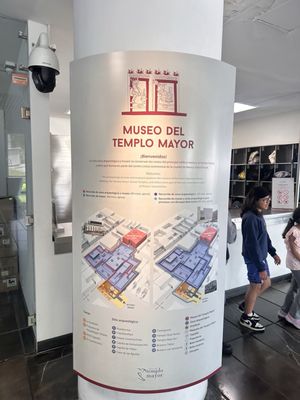Templo Mayor Museum
Aztec temple ruins & museum with extensive artifacts
Information
Seminario 8, Centro Histórico de la Cdad. de México, Centro, Cuauhtémoc, 06060 Ciudad de México, CDMX, Mexico Get directions
Aztec temple ruins & museum with extensive artifacts

























Seminario 8, Centro Histórico de la Cdad. de México, Centro, Cuauhtémoc, 06060 Ciudad de México, CDMX, Mexico Get directions

"If you omit the pyramids outside of the metropolitan zone, there is no greater archaeologically significant site in Mexico City than Templo Mayor, the fantastical fortress of the Aztec Empire. In the 16th century, the Aztec city was physically and spiritually crushed by the Spanish conquistadors. There are two sections: the outside pathways that pass through the ruins, which are in active excavation with archeologists and students working below, and the interior museum, which contains other stonework, baskets, totems, skulls, and friezes, spread out over eight large rooms. Inside, you can also see the construction and remarkable detailing of the temple—all those steps and slants. The entrance can be a bit confusing: It's accessed from the northeast corner of the Zocalo." - Scarlett Lindeman, Susannah Rigg

"Once the centerpiece of Tenochtitlán, the ancient Aztec capital, constructed in 1325 in the marshes of Lake Texcoco, this main temple was mowed over and replaced by a cathedral during the Spanish conquest in 1521. Incredibly, the push to excavate the temple didn't occur until the late 1970s. Today, the hulking stone ruins lie at the heart of Centro Histórico. Embedded in the blueprint of downtown, and somewhat consumed by the scrum of the streets and surrounding buildings, it's hard to imagine the temples in their original Aztecan glory. Fortunately, the open-air archeological site has a nicely organized museum right behind it. The various artifacts and renderings of the great city of Tenochtitlán contained within make it easier to picture. If you are interested in the history of Mexico City, Templo Mayor is a nice way to while away an afternoon." - Scarlett Lindeman

"An archaeological museum built around the ruins of an ancient ceremonial center, offering affordable access to pre-Hispanic artifacts and history." - Lauren Dana Ellman Lauren Dana Ellman Lauren Dana Ellman is a New York-based writer and editor who specializes in travel, lifestyle, food, and shopping content. Travel + Leisure Editorial Guidelines

"The ruins of Tenochtitlan, the capital of the old Aztec empire, lie beneath Centro Histórico, and Templo Mayor is the main structure that was unearthed by archaeologists in the 1970s. After visiting the archaeological site, head next door to the museum, where most of the pre-Columbian pieces recovered from the area are on display." - MATADOR_NETWORK

"The Templo Mayor With the Spanish conquest of the Aztec empire, Iberian overlords set about imposing their customs on the subdued populace, eliminating traces of pre-Hispanic religions they deemed heretical by demolishing major temples and building churches and other structures atop their ruins. Centuries later, in 1978, workers laying electrical lines happened upon the remains of the Templo Mayor, the Aztecs’ most important ceremonial center (and, yes, the location of their notorious human sacrifices). Subsequent excavations have revealed superimposed pyramid foundations and priceless artworks, many now displayed at the on-site museum. Thrillingly, treasures keep turning up—including the spring 2017 discovery of a stone box containing some of the finest Aztec gold ever found, just off the Templo Mayor's steps."
